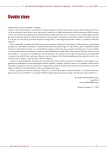Locomotive activity in prevention blood- vessel complication and diabetes
Authors:
K. Barták 1; J. Radvanský 2
Authors‘ workplace:
Ústav tělovýchovného lékařství Lékařské fakulty UK a FN Hradec Králové, přednosta doc. MU Dr. Karel Barták, CSc. 2Klinika rehabilitace a tělovýchovného lékařství 2. lékařské fakulty UK a FN Motol Praha, přednosta doc. PaeDr. Pavel Kolář, Ph. D.
1
Published in:
Vnitř Lék 2010; 56(4): 292-294
Category:
11th National Diabetes Symposium "Diabetes and Angiology", Hradec Kralove, 5 to 6 June 2009
Overview
Adequate, gradual, regular and locomotive diversified physical activities and training is at present a substantial part of treatment virtually in all patients with both type 1 and type 2 diabetes mellitus (T1DM and T2DM). In postgraduate conceived lecture authors explained meaning and indications of physical activities in primary and secondary prevention of metabolic syndrome and its complications. The lecture is focused also on relative contraindications of physical activities and sports in patients with T1DM and T2DM.
Key words:
diabetes mellitus – metabolic syndrome – exercise – physical activity benefit – exercise contraindication, recommended physical activities
Sources
1. Reaven GM. Banting lecture 1988. Role of insulin resistence in human disease. Diabetes 1988; 37: 1595– 1607.
2. Astrand PO, Rodahl K. Textbook of Work Physiology. New York: McGraw- Hill Book Company 1970.
3. McArdle W, Katch FI, Katch VL. Exercise physiology, nutrition and human performance. Philadelphia, Baltimore, NY, London: Lippincot, Wiliams & Wilkins 2005.
4. Placheta Z, Siegelová J, Štejfa M et al. Zátěžová diagnostika v ambulantní a klinické praxi. Praha: Grada 1999.
5. Albright A, Franz M, Hornsby G et al. American college of sports medicine position stand. Exercise and Type 2 Diabetes. Med Sci Sports Exerc 2000; 32: 1345– 1360.
6. Perušicová J et al. Diabetologie. Praha: Triton 2008.
7. Bureš J, Horáček J. Základy vnitřního lékařství. Praha: Galén 2003.
8. Svačina Š. Prevence diabetu a jeho komplikací. Praha: Triton 2008.
9. Svačina Š et al. Klinická diabetologie. Praha: Grada 2008.
10. Svačina Š. Hypertenze při obezitě a diabetu. Praha: Triton 2007.
11. Svačina Š et al. Metabolický syndrom. 3rd ed. Praha: Triton 2007.
12. Svačina Š, Bretšnajdrová A. Jak na obezitu a její komplikace. Praha: Grada 2008.
13. Svačina Š. Cévní komplikace diabetu. Praha: Galén 2005.
14. Pelikánová T et al. Trendy soudobé diabetologie. Svazek 11. Praha: Galén 2007.
15. Grundy SM, Cleeman JI, Daniels SR et al. American Heart Association/ National Heart, Lung, and Blood Institute Scientific Statement. Diagnosis and Management of the Metabolic Syndrome. Circulation 2005; 112: 2735– 2752.
16. Sigal RJ, Kenny GP, Wasserman DH et al. Physical activity/ exercise and type 2 diabetes: a consensus statement from the American Diabetes Association. Diabetes Care 2006; 29: 1433– 1438.
17. Rybka J. Diabetologie pro sestry. Praha: Grada Publishing 2006.
18. Radvanský J. Léčba pohybem u diabetika 2. typu. Medical Tribune 2006; 2: 10.
19. Vojáček J, Kettner J. Klinická kardiologie. Hradec Králové: RNDr. F. Skopec, CSc.,Nukleus HK 2009.
20. Škrha J et al. Diabetologie. Praha: Galén 2009.
21. Hawley JA. Exercise as a therapeutic intervention for the prevention and treatment of insulin resistance. Diabetes Metab Res Rev 2004; 20: 383– 393.
22. Pencek RR, James FD, Lacy DB et al. Interaction of insulin and prior exercise in control of hepatic metabolism of a glucose load. Diabetes 2003; 52: 1897– 1903.
23. Svačinová H. Pohybová léčba u pacientů s metabolickým syndromem. Vnitř Lék 2007; 53: 540– 544.
24. Svačinová H, Nováková M, Placheta Z et al. Benefit Combined Cardiac Rehabilitation on Exercise Capacity and Cardiovascular Parameters in Patients with Type 2 Diabetes. Tohoku J Exp Med 2008; 215: 103– 111.
25. Škrha J. Hypoglykemický syndrom. Praha: Grada 2001.
26. Kvapil M, Perušicová J. Postprandiální glykémie. Praha: Triton 2006.
Labels
Diabetology Endocrinology Internal medicineArticle was published in
Internal Medicine

2010 Issue 4
Most read in this issue
- Angiopathy and the eye
- Peripheral arterial disease and diabetes
- Surgical treatment of ischemic heart disease and diabetes mellitus
- Diabetes mellitus and ischemic heart disease
